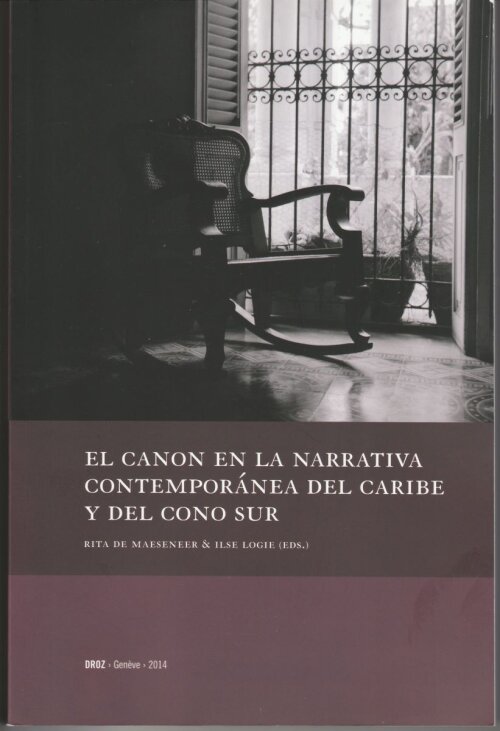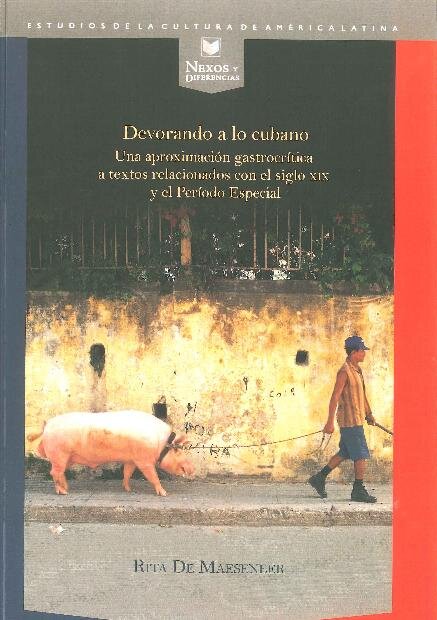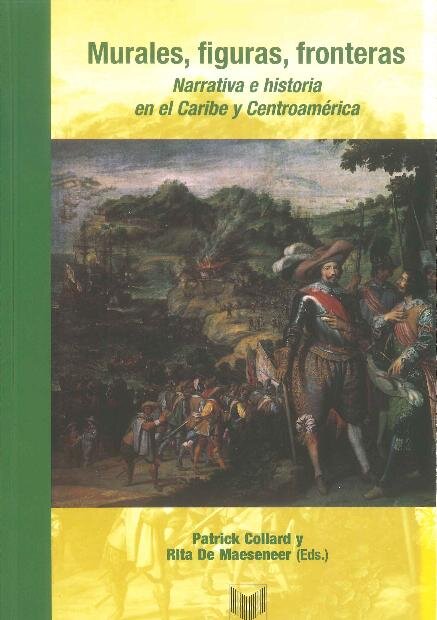Publications
De Maeseneer, Rita, Logie, Ilse (eds.) (con la colaboracion de Ana Maria Moreno Bruna). El canon en la narrativa contemporanea del Caribe y del Cono Sur. Droz: Genève: Romanica Gandensia XLVI, 2014.
In this edition 16 scholars specialized in Caribbean, Argentinian and Chilean literature tackle issues related to canon and canon formation: relativism of canon, mechanisms of consecration, the impact of the market , the definition of literary 'qualilty' and cultural values, the relation with the 'pantheon', the importance of place and time in the cultural battlefield, the relation with the World Republic of Letters. Special attention is devoted to the role of anthologies in canon formation.

De Maeseneer, Rita. Devorando a lo cubano. Una aproximación gastrocrítica a textos relacionados con el siglo XIX y el Período Especial. Madrid y Frankfurt am Main: Iberoamericana-Vervuert, 2012.
Devorando a lo cubano offers a “gastrocritical” approach examining various works from the 19th century and the Special Period in Cuba. For the 19th century, Rita De Maeseneer establishes a dialogue based on racial, social, proto-identitarian and meta-literary approaches taking as a starting point the culinary references from Cecilia Valdés by Cirilo Villaverde, La Havane by la Condesa de Merlin, Fredrika Bremer’s travelers’ tales and Cimarrón by Miguel Barnet. Furthermore, De Maeseneer approaches the Special Period from the esthetic of the absence, present in the novels of Leonardo Padura Fuentes, Zoé Valdés, Daína Chaviano, Pedro Juan Gutiérrez, Karla Suárez, Ena Lucía Portela, Robert Arellano and Ronaldo Menéndez. As a conclusion, the book provides a reflection on the essay of Antonio José Ponte Las comidas profundas. Textual analyses as well as film references from the post-soviet period.are accompanied by illustrations of labels and lithographs from the 19th century.

De Maeseneer, Rita. Seis ensayos sobre narrativa dominicana contemporánea. Santo Domingo, Banco Central, 2011.
The six essays focus on some recurrent topics in contemporary Dominican literature. The author examines first the failures and assets of the narrative on (neo)trujillato. Then she offers some key aspects to read with a different approach the novel Sólo cenizas hallarás (bolero), by Pedro Vergés. She analyzes Junot Díaz’s The Brief Wondrous Life of Oscar Wao as an oblique and direct approach to authoritarian structures such as the trujillato. The urban chronotopes are questionned in the contemporary chronicles by Aurora Arias. She addresses also the multilayered short novels by Rita Indiana Hernández. Finally, she compares two Caribbean texts on the same topic, boatpeople, as evoked by Dominican writer José Alcántara Almánzar y and Puerto Rican author Mayra Santos-Febres.

De Maeseneer Rita, Collard, Patrick (eds.). Saberes y sabores en México y el Caribe. Amsterdam : Rodopi, 2010.- 356 p. (Foro Hispánico ; 39)
Saberes y sabores en México y el Caribe is one of the results of the research project called “Los contextos culinarios en la literatura del Caribe hispano y de México del siglo XVI al siglo XX”. It offers, from a “gastrocritical” approach, an analysis of texts from different periods for the two considered areas. Fourteen specialists comment on the various culinary connotations present in the work of Bernal Díaz del Castillo, Sor Juana, José Tomás de Cuéllar, Martín Luis Guzmán, Sandra Cisneros and Sara Sefchovich, specialized in Mexico. Some of the researched writers for the Caribbean area are Pedro Mártir de Anglería, Frederika Bremer, Leonardo Padura Fuentes, Edgardo Rodríguez Juliá and Nancy Alonso. The contributions were made by Adolfo Castañón, Kim Huyge, Eugenia Houvenaghel, Catherine Raffi-Beroud, Carmen de Mora, Diana Castilleja, An Van Hecke, José Guerrero, Rita De Maeseneer, Efraín Barradas, René Vázquez Díaz, Elzbieta Sklodowska, Jacques Joset and Patrick Collard.. The present edition shows the richness of interpretation of what Alejo Carpentier called culinary contexts.

De Maeseneer, Rita, Mercado Rodríguez, Salvador. Ocho veces Luis Rafael Sánchez. Madrid, Verbum, 2008.
In Ocho veces Luis Rafael Sánchez, both authors have contributed with four essays each. Their work focuses on La guaracha del Macho Camacho and La importancia de llamarse Daniel Santos. It is a compilation of innovative studies about the problematic relationship between the author and the canonical and foundational texts of the “lettered city”, the dialogue with (post) modern theories and with mythologies in the sense of Barthes, the clash between music and words and Caribbeanness . The authors’ different backgrounds have enriched the variety of approaches, interconnecting and merging their views. Their essays illustrate the richness of Sánchez’s narrative prose and invite to reconsider important topics of the Caribbean and Latin American literature. They also broaden and give more complexity to the image of Luis Rafael Sánchez, sometimes excessively associated to orality and popular culture.

De Maeseneer, Rita. Encuentro con la narrativa dominicana contemporánea. Madrid : Iberoamericana, 2006.
The author studies frequent approaches in Latin American contemporary narrative comparing Dominican writers’ texts and texts from authors outside the island. She approaches the Trujillato in the work of Efraím Castillo, Pedro Peix and Mario Vargas Llosa. She addresses the Massacre of 1937 comparing Freddy Prestol Castillo’s and Edwidge Danticat’s novels. She links the urban dimension of Rita Indiana Hernández’s novels with the X Generation while she approaches the Dominican migration to Puerto Rico through the texts of José Alcántara Almánzar, Ana Lydia Vega and Magali García Ramis. Furthermore, the author relates Pedro Vergés’s use of bolero to other Caribbean authors . The aim is to promote and to make known the emerging contemporary Dominican narrative.

De Maeseneer Rita, Van Hecke An (eds.). El artista caribeño como guerrero de lo imaginario. Madrid : Iberoamericana, 2004.
Could the contemporary artist of the Caribbean who faces situations of discrimination and oppression be called an “imaginary warrior”? Is it still possible to underscore the rebelliousness of the artists? The idea of the “imaginary warrior” has inspired Mayra Santos-Febres, Denis Henriquez and René Vásquez Díaz to reflect on their work. This paradoxical and multilayered concept has been the starting point for experts in visual arts as well as in literature to reveal the “warrior” strategies used by authors such as Luis Rafael Sánchez, Ana Lydia Vega or Reinaldo Arenas.

Collard Patrick, De Maeseneer Rita (eds.). Murales, figuras, fronteras : narrativa e historia en el Caribe y Centroamérica. Frankfurt am Main : Vervuert, 2003.
Is it still relevant in Central America and the Caribbean to talk about the “New historical novel” as Seymour Menton defined it? In the present work, fourteen renowned experts analyze the historical approach made by authors of this region. Their main objectives are: the consolidation of the idea of a nation in countries sometimes too dependent on “external” influences, the revision of some historical leading figures and the redefinition of the historical novel’s genre by experimenting with new sub-genres. By transforming traditional historical genres, authors such as Francisco Herrera Luque, Julio Escoto, Sergio Ramírez, Antonio Benítez Rojo, Olga Nolla, Marcio Veloz Maggliolo and Gabriel García Márquez continue to insert fiction in history as well as history in fiction.

De Maeseneer, Rita. El festín de Alejo Carpentier. Una lectura culinario-intertextual. Genève: Droz. 2003.
Having explored the literary critical relevance of what she has coined ‘gastrocriticism’, Rita De Maeseneer studies the multiple implications of the culinary references in the oeuvre of Alejo Carpentier. In addition, she proposes a detailed analysis of literary intertextuality (a metaphoric way of eating) in “El camino de Santiago” and “La consagración de la primavera”. These apparently opposite approaches (“Low” vs. “High” culture) illustrate the paradoxes in Alejo Carpentier’s poetics.
